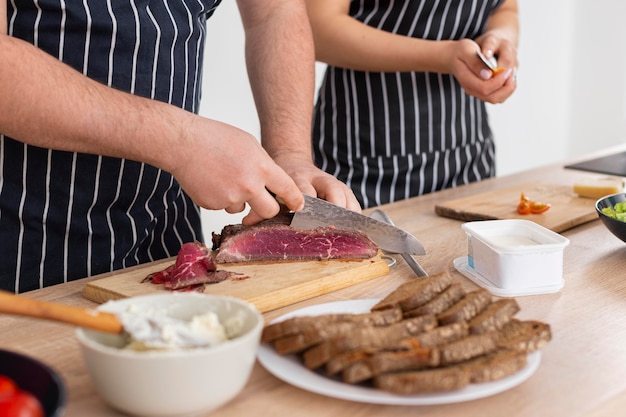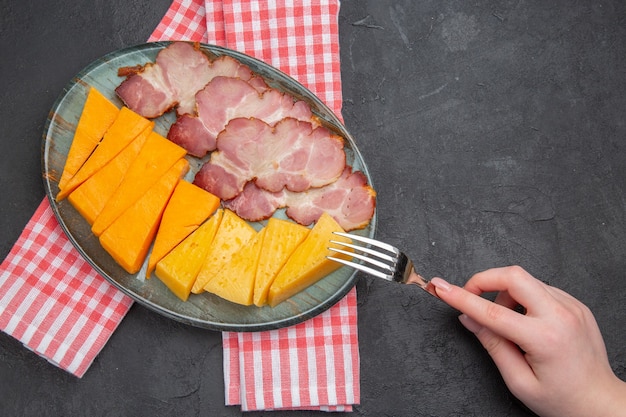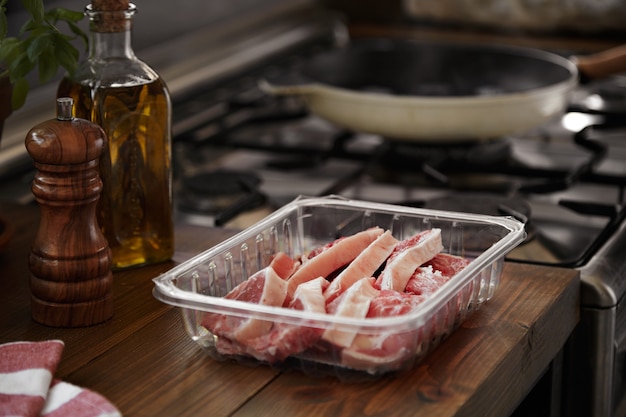I'll admit it, I'm a bacon enthusiast. But with a penchant for healthy eating, I've found solace in turkey bacon. It's the perfect compromise - that smoky, salty flavour we all love, without the guilt-inducing fat content.
However, cooking turkey bacon can be a bit of a dance. It can dry out quickly and become rubbery if you're not careful. But fear not! I've spent years perfecting my turkey bacon game, trying out different methods and techniques. Today, I'm sharing all my tips and tricks to help you achieve that perfectly crispy, juicy, and flavourful result.
(Part 1)
The Turkey Bacon Landscape: A Guide to the Different Types

Before we dive into the cooking process, let's talk about the different types of turkey bacon available. It's not a one-size-fits-all scenario, and understanding the variations will help you choose the best one for your needs and ensure you cook it correctly.
The Classics:
- Regular Turkey Bacon: This is the most common type, usually found in pre-sliced packages. It's typically thin and flat, delivering a more "traditional" bacon flavour. It's a great all-rounder for breakfast sandwiches, salads, and more.
- Thick-Cut Turkey Bacon: For those who love a meatier bite, thick-cut turkey bacon is a real treat. It takes a bit longer to cook, but the added chewiness and richness are worth the wait. It's ideal for serving alongside eggs and pancakes or adding a touch of gourmet to your meal.
- Turkey Bacon Strips: These are similar to regular turkey bacon but often have a more "rustic" look, sometimes with a bit of marbling. They can be a bit more uneven in thickness, so keep a closer eye on them during cooking.
Stepping it Up:
- Seasoned Turkey Bacon: Want to add a bit of zing to your bacon? Look for seasoned turkey bacon. These often come in flavours like maple, pepper, or garlic, offering a delicious twist on the classic bacon experience. Just be aware that the added seasonings can make them a little trickier to cook evenly.
- Turkey Bacon Crumbles: These pre-cooked bits of turkey bacon are absolute lifesavers. Perfect for salads, soups, pasta dishes, or even adding to your favourite burger, they're a convenient and flavourful way to add a touch of bacon magic. Since they're already cooked, you can just add them at the end of cooking to avoid over-cooking.
Decoding Turkey Bacon Cook Times: It's Not One-Size-Fits-All

Now for the real meat of the matter (pun intended) – cook times. Here's where things get a bit tricky, as there's no single "perfect" time for every situation. The type of bacon, the pan you use, and even the temperature of your stove can all influence how long it takes.
But don't despair! I'm breaking down the cooking time based on different methods, and I'm giving you essential tips to ensure your turkey bacon is cooked to perfection.
(Part 2)
Pan-Fried Turkey Bacon: The Classic Method

Pan-frying is the most popular method for cooking turkey bacon, and for good reason. It's simple, reliable, and produces that crisp, golden brown exterior we all crave.
Your Essential Tools:
A cast iron skillet or non-stick frying pan – these provide even heat distribution and prevent sticking.
A bit of oil or cooking spray – this will prevent the bacon from sticking to the pan.
A spatula or tongs – for flipping the bacon without breaking it.
Steps to Crispy Goodness:
- Warm Up the Pan: Place your skillet over medium heat and let it warm up for about a minute. This ensures the pan is hot enough to sear the bacon properly.
- Add a Touch of Grease: Add a thin layer of oil or spray the pan with cooking spray. This prevents sticking and helps the bacon brown beautifully.
- Lay it Out: Place the slices of turkey bacon in a single layer, leaving a little space between each piece. Don't overcrowd the pan, or the bacon will steam rather than crisp. Give each slice its own space to breathe.
- First Side Sizzle: Let the bacon cook on one side for about 3-5 minutes, or until it starts to brown. Resist the temptation to flip it too early; it might stick to the pan.
- Flip It: Carefully flip the bacon using a spatula or tongs. Cook for another 2-3 minutes on the other side, or until it's cooked through and crispy.
- Drain and Cool: Remove the bacon from the pan and place it on a plate lined with paper towels to absorb any excess grease. Let it cool slightly before serving. This allows the bacon to crisp further and absorb the paper towels for a less greasy result.
Tips to Elevate Your Pan-Frying Game:
- Spacing is Key: Don't overcrowd the pan. Give the bacon room to cook evenly, ensuring that all sides get nice and crispy.
- Keep an Eye on It: Turkey bacon cooks quickly, so stay vigilant and flip it when it's ready. Overcooked bacon can become tough and rubbery.
- Experiment with Heat: If you're after extra-crispy bacon, you can increase the heat slightly. Just be careful not to burn it! Monitor the bacon closely and adjust the heat accordingly.
(Part 3)
oven-baked turkey Bacon: A Low-Maintenance Option
For a more hands-off approach, oven-baking turkey bacon is the way to go. It's also perfect for cooking larger quantities, as you can fit more slices on a baking sheet.
What You'll Need:
A baking sheet – line it with parchment paper to prevent sticking.
A wire rack (optional) – This helps air circulate around the bacon, resulting in crispier bacon.
Steps to Baking Perfection:
- Preheat Your Oven: Set your oven to 400 degrees Fahrenheit (200 degrees Celsius).
- Arrange the Bacon: Place the slices of turkey bacon on the baking sheet in a single layer, leaving a little space between each piece. If you're using a wire rack, place it on top of the baking sheet and then lay the bacon on the rack. This allows air to circulate around the bacon for even cooking and optimal crispiness.
- Bake It: Bake the bacon for 10-15 minutes, or until it's cooked through and crispy. Keep a close eye on it, as it can cook quickly.
- Cool and Serve: Remove the bacon from the oven and let it cool slightly on the baking sheet. Then, transfer it to a plate lined with paper towels to absorb any excess grease.
Tips for Oven-Baked Success:
- Parchment Paper is Your Friend: It prevents sticking and makes cleanup a breeze.
- Don't Overcrowd: Give each slice its own space to ensure even cooking and prevent steaming.
- Flip for Extra Crispness: For extra crispy bacon, flip the slices halfway through cooking. This ensures even browning and a delicious crunch.
- Adjust Cooking Time: Based on your desired level of crispiness, adjust the cooking time. Check the bacon frequently to avoid overcooking.
(Part 4)
Air Fryer Turkey Bacon: Quick and Easy
Air fryers are a kitchen game-changer, and for turkey bacon, they're pure magic. They cook quickly, deliver a satisfyingly crispy result, and are incredibly easy to use.
What You'll Need:
An air fryer
A wire rack (optional) – This helps circulate air and ensures even cooking.
Steps to Air Fryer Bliss:
- Preheat Your Air Fryer: Set your air fryer to 400 degrees Fahrenheit (200 degrees Celsius).
- Arrange the Bacon: Place the slices of turkey bacon in a single layer in the air fryer basket. If you're using a wire rack, place it in the basket and then lay the bacon on the rack. This promotes even cooking and helps the bacon crisp up beautifully.
- Air Fry It: Cook the bacon for 5-7 minutes, or until it's cooked through and crispy. Check it every few minutes to prevent overcooking.
- Cool and Serve: Remove the bacon from the air fryer and let it cool slightly. Then, transfer it to a plate lined with paper towels to absorb any excess grease.
Tips for Air Fryer Excellence:
- Avoid Overcrowding: Give the bacon enough space to cook evenly and crisp up beautifully.
- Shake It Up: To ensure even cooking, shake the air fryer basket halfway through the cooking time. This helps move the bacon around and ensures all sides get crispy.
- Adjust the Cooking Time: Based on your desired level of crispiness, adjust the cooking time. Start with a shorter time and check the bacon frequently to prevent overcooking.
(Part 5)
Microwave Turkey Bacon: A Quick Fix
We've all been there – mornings when we're running late and need a quick breakfast. Microwaving turkey bacon is a lifesaver in these moments. While it might not be the most flavourful method, it gets the job done quickly.
What You'll Need:
A microwave-safe plate
Paper towels – These will absorb excess grease and prevent splattering.
Steps to microwave bacon:
- Lay Out the Bacon: Place the slices of turkey bacon on a microwave-safe plate lined with paper towels.
- Microwave It: Microwave the bacon for 1-2 minutes, or until it's cooked through and slightly crispy. The exact time will vary depending on your microwave's wattage. Start with a shorter time and add more time as needed. It's best to err on the side of undercooking than overcooking.
- Flip It: Flip the bacon over and microwave for another 30 seconds, or until it's reached your desired level of crispiness. Again, check frequently to avoid overcooking.
- Cool and Serve: Remove the bacon from the microwave and let it cool slightly on the plate. Then, transfer it to a plate lined with paper towels to absorb any excess grease.
Tips for Microwaving Mastery:
- Paper Towels are Key: They absorb excess grease and prevent splattering in the microwave.
- Keep an Eye on It: Turkey bacon can cook quickly in the microwave, so watch it closely to prevent overcooking. Check it every 30 seconds or so.
- Don't Expect a Full-On Crunch: Microwave turkey bacon won't be as crispy as bacon cooked in a pan or oven, but it's a decent option for a quick breakfast fix.
(Part 6)
How to Tell If Turkey Bacon Is Cooked: Don't Guess, Test!
One of the most common questions I get about turkey bacon is: “How do I know if it’s cooked?” Well, here are a few ways to tell, so you can be confident in your bacon-cooking abilities.
The Colour Test:
Raw turkey bacon: Has a pale pink colour.
Cooked turkey bacon: Turns a light brown, almost tan, colour. You should see a bit of browning on the edges as well.
The Touch Test:
Raw turkey bacon: Will be cold and soft.
Cooked turkey bacon: Will be firm and springy to the touch.
The Temperature Test:
Safe internal temperature: The internal temperature of cooked turkey bacon should reach at least 155 degrees Fahrenheit (68 degrees Celsius). You can use a meat thermometer to ensure it's cooked through.
(Part 7)
Troubleshooting Common Turkey bacon cooking Problems: Saving Your Bacon
So, you've followed all the tips, but your turkey bacon still isn't turning out quite right? Don't worry, we've all been there. Here are some common problems and their solutions to help you troubleshoot and achieve bacon perfection:
Turkey Bacon Is Too Dry:
Solution: Try using a little less heat or cooking the bacon for a shorter amount of time. You can also add a tablespoon or two of water to the pan while cooking to help create steam and prevent the bacon from drying out.
Turkey Bacon Is Too Rubbery:
Solution: Overcooked turkey bacon can become tough and rubbery. Try cooking it for a shorter amount of time or using a lower heat setting.
Turkey Bacon Is Not Crispy Enough:
Solution: If your turkey bacon isn't crispy enough, try cooking it for a few more minutes or increasing the heat slightly. Just keep an eye on it to avoid overcooking.
Turkey Bacon Is Sticking to the Pan:
Solution: Make sure your pan is properly heated and greased before adding the bacon. You can also use a non-stick cooking spray to help prevent sticking.
(Part 8)
Storing and Reheating Turkey Bacon: Keeping It Delicious
Once you've cooked your turkey bacon, you'll want to store it properly to maintain its freshness and flavour.
Storing Turkey Bacon:
Refrigerator: To store leftover turkey bacon, simply place it in an airtight container and refrigerate for up to 3-4 days. This will help prevent it from drying out and preserve its flavour.
Freezer: You can also freeze cooked turkey bacon for up to 2-3 months. Wrap it tightly in plastic wrap or aluminum foil before placing it in a freezer bag. This helps prevent freezer burn and keeps it fresh for longer.
Reheating Turkey Bacon:
Microwave: To reheat cooked turkey bacon, simply place it on a microwave-safe plate and microwave for a few seconds, until heated through. Keep a close eye on it to prevent overcooking, which can make it tough.
Oven: For a crispier result, you can reheat the bacon in a preheated oven at 350 degrees fahrenheit (175 degrees Celsius) for about 5-7 minutes. This method brings back the crispiness and delivers a more flavorful result.
Pan: For the best flavour and texture, reheat the bacon in a skillet over medium heat for a few minutes. This is the most flavorful way to reheat turkey bacon as it allows the fat to render and create that delicious crispy texture.
(Part 9)
FAQs: Answers to Your Turkey Bacon Questions
Let's address some of the most frequently asked questions about turkey bacon. I've got you covered!
1. Is Turkey bacon healthier Than Regular Bacon?
Yes, turkey bacon is generally considered healthier than regular bacon because it contains less fat and fewer calories. It's a great option for those who want to enjoy the taste of bacon without the added saturated fat. However, it's still important to consume it in moderation as part of a balanced diet.
2. Can You Eat Turkey Bacon Raw?
No, it's not safe to eat turkey bacon raw. It can contain harmful bacteria that can make you sick. Always cook turkey bacon thoroughly to ensure it's safe to eat.
3. Why Is My Turkey Bacon Greasy?
Turkey bacon does contain some fat, but it's usually less greasy than regular bacon. If you find your turkey bacon is excessively greasy, you might be cooking it at too high a temperature or overcrowding the pan. Try adjusting the heat or giving the slices more space to cook.
4. What Can I Do With Leftover Turkey Bacon?
Leftover turkey bacon is a versatile ingredient with endless possibilities! Add it to salads, pasta dishes, sandwiches, soups, or even stir-fries. It's a delicious way to add a smoky, salty flavour to a variety of meals.
5. How Can I Make My Turkey Bacon More Flavourful?
You can elevate your turkey bacon game by adding a little extra flavour. Here are a few ideas:
Marinade: A simple marinade of olive oil, lemon juice, and garlic can add a boost of flavour. Let the bacon marinate for at least 30 minutes before cooking.
Seasoning: Experiment with spices like paprika, chili powder, or black pepper. Add a sprinkle of seasoning to the bacon before cooking for an extra kick.
Maple Syrup Glaze: Brush a maple syrup glaze over the bacon during the last few minutes of cooking for a sweet and smoky treat.
(Part 10)
Experiment and Enjoy!
Now that you're armed with the ultimate guide to cooking turkey bacon, it's time to get creative and experiment. Whether you're whipping up a quick breakfast or adding some smoky goodness to a dinner dish, turkey bacon is a delicious and versatile ingredient. So, go ahead and give it a try. And remember, don't be afraid to experiment and find your own perfect way to cook it. Happy bacon-ing!
Everyone is watching

Corn on the Cob: The Ultimate Guide to Perfectly Cooked Ears
Healthy MealsAh, corn on the cob. Just the name evokes images of sunny days, barbecues, and that sweet, juicy flavour that ...

Perfect Pork Roast Oven Cooking Time: A Guide to Delicious Results
Healthy MealsThere's something truly satisfying about a perfectly roasted pork. The aroma alone is enough to make your mout...

Ham Cooking Time: How Long to Bake, Smoke, or Boil a Delicious Ham
Healthy MealsAh, ham. It's a classic, isn't it? A real crowd-pleaser, especially around holidays. And when done right, it'...

Scallops: The Ultimate Guide to Perfect Cooking
Healthy MealsAh, scallops. Those delicate, sweet, and utterly delicious morsels of the sea. They hold a special place in my...

Spaghetti Squash: The Ultimate Guide to Cooking and Serving
Healthy MealsRemember that time you saw spaghetti squash at the supermarket, looking all bumpy and strange, and thought, "W...
